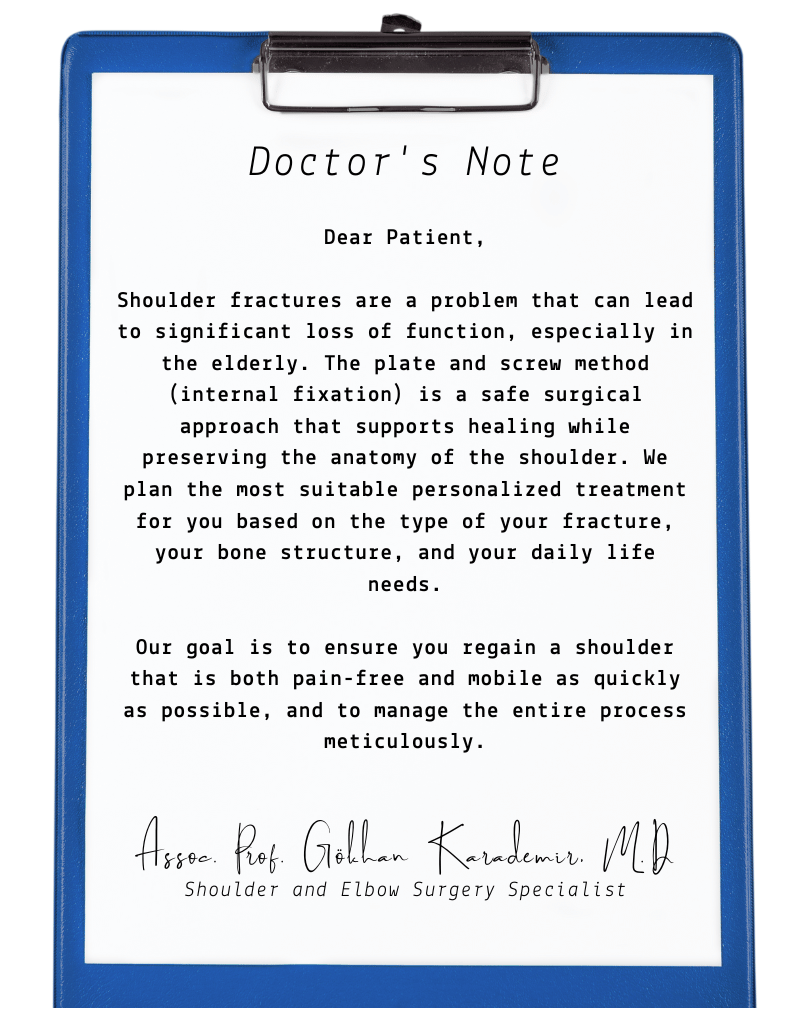Shoulder fractures are common injuries, particularly in elderly individuals, often resulting from falls. A significant portion of these fractures occurs in the “proximal humerus,” which is the part of the upper arm bone closest to the shoulder.
While simple and non-displaced fractures (where the bone fragments remain aligned) can often be treated without surgery, in some cases, surgical intervention becomes unavoidable.

Surgical treatment with plates and screws is one of the most frequently applied methods for fractures where the bone ends are displaced (moved out of position), comminuted (broken into multiple pieces), or extend into the joint. In this technique, the fracture site is accessed through open surgery, the bone fragments are anatomically aligned (restored to their natural position), and then stabilized using specially designed titanium plates and screws. This allows the bones to heal correctly and aims to restore the shoulder’s function.
The plate and screw method is often preferred for younger patients and those with good bone quality. The success rate is particularly high if the number of fracture fragments is three or fewer and there is no severe crushing of the humeral head (the ‘ball’ of the shoulder’s ball-and-socket joint). With a proper physical therapy process after surgery, the majority of patients can regain functional movement in their shoulder.

Surgery Duration: Approximately 1.5-2.5 hours
Type of Anesthesia: General anesthesia (supported by a nerve block if necessary)
Surgical Method: The fracture is stabilized using a special plate and screw system via open surgery
First day: 4–6
First week: 3–4
After 2 weeks: 1–2
A hospital stay of 1 or 2 nights is generally recommended
First 2 weeks: Supported with an arm sling
Starting from the 3rd week: Passive movements begin
6th week: Transition to active movements
3rd month: Return to daily living activities 6th month: Return to high-impact activities, such as sports
First dressing change: 2nd day
Suture (stitch) check: 1st week
Suture removal (if applicable): 10th day
No. The degree of fragmentation (how many pieces the bone is in), the patient's age, and bone quality determine the suitability of this method. In cases of severely comminuted (fragmented) fractures, a crushed humeral head, or osteoporotic (weakened) bone, a shoulder prosthesis (joint replacement) may be the preferred treatment.
Early and regular exercises are critical to prevent loss of function. In most cases, the home exercise program we provide to our patients is sufficient and safe. If, during follow-up appointments, it is noted that the patient is not achieving the expected range of motion, formal physical therapy may be recommended. Starting exercises early is essential for preserving the shoulder's range of motion and muscle strength.
In most cases, the plates and screws (implants) do not need to be removed. However, if they cause discomfort, they can be removed after the bone has fully healed.
With regular exercises, the majority of patients can achieve a full or near-full range of motion.
With appropriate patient selection, the correct surgical technique, and consistent rehabilitation, it is possible to achieve success rates greater than 95%.